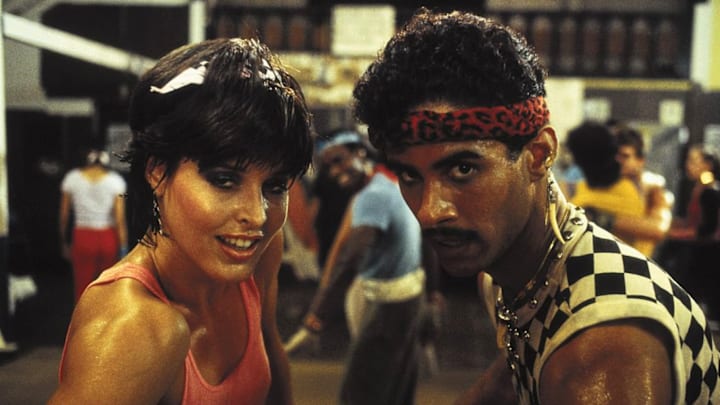“The breakdance tornado approaches,” Variety proclaimed ahead of the release of 1984’s Breakin’, one of many Hollywood attempts that year to capitalize on the world of popping, locking, and, of course, electric boogaloo. Ultimately, the dance craze didn’t quite cause the devastation forecasted; the fickle world of pop culture soon downgraded its effect to more of a near-gale. Still, for a brief moment, it really did seem as if the breakdancing scene was about to crash the box office.
Breakin’ and Enterin’
Inspired by Breakin’ ‘n’ Enterin’, a 1983 documentary about Los Angeles’s hip hop scene, Joel Silberg’s Breakin’ was the first breakdancing movie to step up. Subsequently, it became a mini-sensation, beating another teen favorite, Sixteen Candles, to the top of the box office in its opening weekend (both were released on May 4, 1984). Breakin’ ended up being the second highest grossing movie during all of May; only Indiana Jones and the Temple of Doom managed to top it. The film’s $38.6 million total gross was impressive enough to make it the 17th biggest film of the year (sandwiched between Revenge of the Nerds and Bachelor Party).
Interestingly, Breakin’ also became the first profitable production from Cannon Films, the famously maverick studio that never missed an opportunity to jump on a bandwagon—perceived or otherwise. Studio head honcho Menahem Golan reportedly greenlit the movie after his daughter became fascinated by a Venice Beach breakdancer. Golan, determined to beat his rivals to the punch, subsequently pressured Silberg and his team to deliver a film in time for the summer season.
That perhaps explains why Breakin’ feels more like a collage of music videos than a cohesive film. There’s a loose narrative: Kelly (Lucinda Dickey), a classically trained performer, teams up with street dancers Ozone (Adolfo "Shabba Doo" Quiñones) and Turbo (Michael "Boogaloo Shrimp" Chambers) to win a dance contest and challenge the notions of the art form itself. But it’s largely an excuse to display the talents of leading lady Dickey and her fabulously named partners-in-crime.
They most memorably achieved this in the movie’s climactic scene where the trio, dressed like the stars of Singin’ in the Rain, suddenly strip off their tuxedos and top hats to convert stuffy judges into breakdance enthusiasts.
Inevitably, this MTV-friendly approach was like catnip to the teens of 1984. Where else would you find street dancers defying the laws of physics against a backdrop of pioneering electronica? Or Ice-T, in a role far removed from his gangster rap future, repeatedly hyping up the crowd while dressed in a diamond-studded harness? The answer to those questions lies in Breakin’ 2: Electric Boogaloo—the hastily made sequel that arrived just seven months after the first film hit theaters.
Electric Boogaloo to the Rescue
Yes, keen to squeeze every last drop out of the breakdancing phenomenon, Cannon Films immediately approved Breakin’ 2: Electric Boogaloo. Directed by Sam Firstenberg, the movie itself was fairly absurd. While its predecessor was at least rooted in some form of reality, Breakin’ 2 appears to take place in an alternate universe where men can moonwalk on the ceiling and dance has the miraculous power to both heal persons with disabilities and bring the dead back to life.
Again, there’s a flimsy excuse for a plot, with the original trio returning to help thwart a cartoonishly evil developer’s dreams of turning a local community center into a shopping mall. And again, the story and characterization play second fiddle to the immaculate choreography and dazzling production design inspired by the golden age of MGM musicals.
But straying even further from the scene’s gritty roots, and with audiences now suffering breakdancing fatigue, Breakin’ 2 made only half the money of the original. That was still enough to dwarf its $3 million budget, and spawn another follow-up, 1985’s Rappin’, which unsurprisingly adhered to the law of diminishing returns. However, it was clear the breakdancing movie was fast becoming yesterday’s news.
The King of the Beat
Unfortunately, the realization that breakdancing movies may already have run their course came too late for a few other films: Marcelo Epstein’s Body Rock made little impression on audiences apart from Maria Vidal’s titular theme and its Razzie-nominated star Lorenzo Lamas’s song “Fools Like Me” becoming minor Hot 100 hits. Contrastingly, Beat Street is considered the breakdancing movement’s cinematic crowning glory.
Directed by Dave Chappelle regular Stan Lathan and produced by the legendary Harry Belafonte, the South Bronx tale provided a much more authentic insight into breakdance culture. It borrowed elements of the ground-breaking hip-hop film Wild Style, graffiti doc Style Wars, and the deceptively downbeat disco classic Saturday Night Fever.
Beat Street centers on two brothers, MC Kenny (Guy Davis) and breakdancer Lee (Robert Taylor), who, alongside their New York posse, try to bring the sounds and the sights of the streets to the masses. Unlike the Breakin’ movies, Beat Street is also infused with real drama, addressing themes of teen pregnancy, parental pressures, and, most notably, gang violence. Far from leaving audiences with a spring in their step, the movie ends in tragedy.
Had Orion Pictures released Beat Street just one month earlier, it may well have surpassed its rather modest $16.6 million gross. But it has since deservedly attained cult classic status and was later referenced in rhyme by AZ, Jay Electronica, and The Notorious B.I.G. Additionally, its anti-capitalist mindset had a hugely influential impact on the pre-unified German hip-hop movement.
The subgenre enjoyed a bit of a revival in the 2000s with the likes of Step Up, You Got Served, and Stomp the Yard. And with breaking making its official debut as a sport at the Summer Olympics in Paris, there is certainly every chance that we could see another wave of breakdancing movies coming our way. But it will be difficult for any modern movement to top 1984’s glut of movers and shakers, who first informed the wider public that breakdancing is “not just kids dancing on a street corner for a nickel!”
